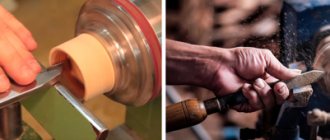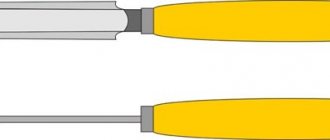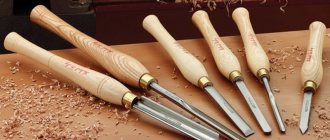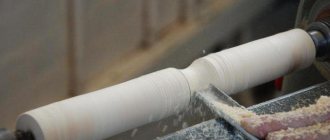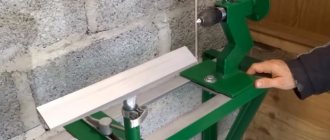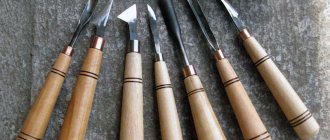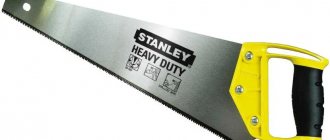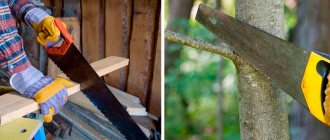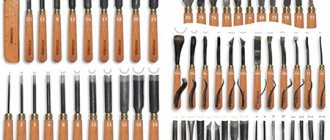SHARE ON SOCIAL NETWORKS
FacebookTwitterOkGoogle+PinterestVk
Wood cutters for a lathe are designed for processing wooden parts on a special machine, which are widely used for the manufacture of furniture or interior elements. The construction market offers a wide range of different types of tools, which are selected based on the scope of use and the material of the wooden workpiece. Everything you need to know about wood cutters can be found in this article.
Special cutters are used as tools for working with a lathe, which have long handles so that the master can hold the tool firmly in his hands
Wood cutters for a lathe: purpose and design of elements
The main purpose of wood turning tools is manual processing of a part rotating in a special machine. The lathe used for these purposes is designed to impart rotation to the body. Wooden blanks, which are initially round in shape, are mounted on a lathe using two clamps. One clamp is connected to an electric motor, which sets the part in motion.
The choice of the type of turning cutter, its sharpening and condition largely determines the possibility of certain operations and the manufacture of parts of the required configuration
Important! On the motor side, the fixation must be rigid so that rotational movements do not occur at idle.
The cutters, which are fixed to the rotating mechanism, perform processing of the rotating body. Depending on the strength, shape and sharpness of the cutter, marks are formed on the wooden workpiece. This also determines the shape of the workpiece.
The design of a lathe cutter consists of a working metal part and a wooden handle. The working element conventionally consists of a blade, body and shank. The blade consists of a front, back and pointed angle. The size of the sharpening angle depends on the material of the workpiece. Most often, craftsmen use sharp corners when working with wood. The body is the main part for which the turner holds the cutter on the armrest of the machine with his non-working hand. The shank is a narrowed part into which the body of the tool goes. It is on this that the handle of the turning tool is attached.
The handle structure consists of a base and a neck. The base is the larger part of the handle that the turner holds with his hand. The neck is represented by a small cylindrical part with a metal fastening ring. It is designed to prevent the handle from cracking while being pressed onto the shank of the working part.
Wood turning tools consist of a back corner, a pointed corner and a rake corner.
Making the handle
To make handles for objects such as machine tools, you need to give the wood a special shape with your own hands. For the handles, oak bars about 12 centimeters long and 12x22 millimeters in cross section are suitable.
- Sand the tail of the metal workpiece along the edges to remove burrs.
- Place the tail on the block and trace the shape with a pen.
- Use chisels to select wood to a depth identical to the thickness of the workpiece. Periodically, the workpiece must be tried on, placing a second block on top. The hole should not be too deep or too shallow - in the first case, the blade will wobble, and in the second, the handle will simply crack or not stick together.
- Once you are sure that all the parts fit together perfectly, you can glue them together. Glue must be applied to the socket and to the surface of the bar. You can apply less glue to the second part.
- Then connect the parts as accurately as possible and tighten them with clamps. You need to do this forcefully, but so as not to split the bars.
- Remove excess glue with a damp cloth and leave everything to dry for about 12 hours.
After this, the tightness of the structure must be checked - grab the handle with one hand, and try to loosen the blade with the other. If you hear characteristic creaks, the work will have to be redone. Don’t be lazy - if hand wood cutters are poorly made, the blade will quickly become loose and can ultimately lead to injury.
Types of wood turning tools
Today on the shelves of hardware stores you can find several types of woodworking tools for lathes: rakes, meisels, chisels, scrapers, trimming cutters, bevel cutters, hooks, rings, combs.
The main purpose of the rafter is the initial, rough, rough processing of the workpiece. The blade of the tool has a special design and is presented in the form of a semicircle. It can be made from a semicircular groove or a thick plate. Using a rayer, the workpiece can be given an approximate outline of the future product.
Meisel is used for finishing and giving the product its final shape. The tool can also be used to cut off the final product from the remains of the workpiece. The shape of a meiser is similar to a jamb knife and is represented by a plate with an oblique blade, sharpened on both sides at the same angle. Using a reyer and a meisel, you can perform turning work of medium complexity. The workpiece is processed along the outer surface. In certain cases, it is possible to work with the internal cavity of parts.
Meisel cutter: a) left-hand sharpening; b) double-sided sharpening; c) right-hand sharpening
Other types of turning cutters belong to the shaped group of products. Chisels are designed for turning smooth surfaces. The blade of the product has a special shape and sharpening. To give the workpiece relief, you can use a special chisel with a knurled roller. Scrapers can have straight or curved cutters, which is convenient for scraping flat or cylindrical wood. This tool can also be used for roughing wood.
Parting cutters have spoon-shaped blades, making it possible to create cups or other semicircular designs. Oblique incisors are represented by grooved chisels, concave chisels and semicircular incisors. The hook and ring are designed to create a cavity of any configuration in the workpiece. The comb is used to create carvings and apply decorative marks and grooves.
Sharpening if the knife is dull
Over time, your knife will, of course, become dull. Then it can be sharpened with sandpaper, and then also polished on the back of the leather belt with GOI paste.
- Wood carving technique
- Let's make it ourselves
- Blade
- Lever
- Sharpening
Knives for wood carving are a must-have accessory in the arsenal of a craftsman who makes decorative objects from natural wood.
Such tools can have different types and shapes, which directly affects the specific processing of individual parts. The most famous cutter, which is very popular among our craftsmen, is the Bogorodsk knife.
How to make wood cutters for a lathe with your own hands
Many craftsmen prefer not to purchase cutters in a store, but to make wood carving tools with their own hands. Meiser and reyer are easy to make. To do this, you can use waste material in the form of files and rasps. These products have the required dimensions, strength, material quality and steel grade. A sharpening machine is used to give the file the required shape. Then a turned handle equipped with a fastening ring is stamped onto the product.
Homemade turning cutters for wood processing: 1 - for deep processing, 2 - for clean processing, 3 - shaped turning, 6 - cutting off, 5 - boring, 6 - for turning balls, 7 - for end shaped turning, 8 - cutter with limiter
You can make wood cutters with your own hands from car springs or reinforcement bars. These materials have the necessary hardness. However, you must be extremely careful with this tool during its further use. The test should be carried out first on soft wood such as poplar or linden. Next, a visual inspection of the tool is carried out for cracks and chips. If they are missing, then homemade wood cutters for a lathe can be used for hardwood.
When making tools for working with wood, it is important to follow certain recommendations. The choice of body length should be based on the possibility of fully grasping it with the hand and resting on the armrest. Here you should also take into account the distance between the armrest and the workpiece and the margin for sharpening and wear. The optimal length is considered to be from 20 to 30 cm. The length of the shank should be calculated in such a way as to eliminate the possibility of it being pulled out of the handle.
Helpful advice ! If files or rasps are used to make cutters, the length of the shank should be increased by 1.5-2 times.
Each person will be able to make homemade cutters that will become an indispensable assistant for surface treatment
The thickness of the working part of the tool must be calculated taking into account to prevent its damage during turning of the workpiece. Therefore, this value should be maximum, which is especially important for large-diameter workpieces. The cutter handle must be at least 25 cm. If this value is smaller, then when performing the turning process the tool will be difficult to hold in your hands, which will negatively affect the quality of the work. You can study in more detail the process of how to make a wood cutter with your own hands on specialized websites on the Internet.
Blade making
If you plan to make wood cutters with your own hands, then you will need a piece of saw blade approximately 8 centimeters long. Of this, 4.5-5 centimeters should be left for the shank, which will be attached to the handle. Using an electric sharpener, the shape of the future knife is cut out of the canvas. The master determines the form himself depending on the requirements. Then you need to grind the shape on a machine, making a large chamfer with an angle of 10-15 degrees. This narrowing from the butt to the cutting edge is necessary so that the cutter can be worked with. A cutting edge with an angle of 25-30 degrees, which will participate in the cutting process, is created later.
This work must be done slowly, otherwise the metal will heat up, become soft and no longer hold an edge. You can sometimes cool the workpiece in water.
Sharpening wood cutters for a lathe
The quality of the processed workpiece largely depends on proper sharpening, namely on the geometry of the turning cutter. The sharpening angle is selected individually by each craftsman depending on his own skills, the hardness of the wood, the quality of the working tool, and the final desired type of the surface being processed.
For a beginning craftsman, the sharpening angle of the chisel and meiser should be 40 degrees relative to the working surface and relative to each side of the blade. For a reyer this value is 50-60 degrees. With increasing skill level, the sharpening angle can decrease to 20-35. The sharpening process is carried out on a special machine for sharpening turning tools, which is equipped with a set of wheels of various grain sizes and a velvet bar for manually straightening the blade.
Before sharpening the cutter, you need to properly fix it in the mandrel.
Helpful advice! A turner's tool set must contain cutters of the same type, uniform size, and having different sharpening angles. This will significantly speed up the work of the specialist and extend the service life of the products, since there will be no need to constantly resharpen the blade, depending on the type of workpiece being processed.
Tools with a sharper sharpening angle are used for rough cutting and hardwood workpieces. Cutting tools with sharper angles allow for better processing of the workpiece surface. It is used to speed up the turning process. However, in this case, the likelihood of damage to the blade and chipping of the workpiece increases. In addition, editing and sharpening wood cutters with sharp corners will be performed more often than elements with obtuse corners.
The approximate sharpening angle of the blade is formed at the stage of manufacturing turning tools before the hardening process begins. After the end of the heat treatment, sharpening is carried out using an abrasive wheel and is completed on a velvet block by hand finishing.
To prevent the appearance of burrs and chips on turned parts, it is important to use correctly sharpened cutters
Criterias of choice
Today, purchasing a tool is quite simple. Many stores provide a wide selection. But how can you avoid running into Chinese disposable products? This is a more complicated question.
It’s best to start by studying specialized forums and listening to the opinions of professionals. And it will be even better if you can find a real master and chat with him “live”.
But this is rare, so when purchasing a set or tool separately, do not hesitate to ask what grade of steel the product is and who the manufacturer is. Take a block of wood with you to the store and try on the spot how the tool will fit in your hand and what its cut will be like.
Price categories vary, but it is clear that a set of 10 items costing 300-400 rubles will not be normal. This means that saving is not worth it here.
Yes, the tool can be quite expensive, but again, a few items are enough for a novice master. And the rest can be purchased as your skill improves.
Which wood turning tools should I buy?
To work on a woodworking machine, it is better to have all the necessary tools. For this purpose, it is better to purchase not just one unit, but a whole set of elements. One of the popular and sought-after options is a set of turning wood cutters Enkor 10430. Here are eight elements of various profiles, which are made of high-speed steel.
The design of the product consists of a cutting part, a base, a wooden handle and a fastening ring. The cutting part with a metal base is rigidly and securely fastened into a wooden handle and securely fixed with a ring that prevents the blade from falling out when working with the product. Each cutter is equipped with a comfortable, long, varnished handle that is comfortable to hold with both hands.
The cutters are sold complete with a wooden box, which is equipped with slots for each element. The blades of the products are made of high-strength steel, which exhibits increased resistance to wear and can remain without sharpening for a long time. The tool allows you to process workpieces made of any type of wood, regardless of the hardness of the wood. High-quality sharpening of the blade allows you to process products of any shape. When using these cutters, labor productivity increases, which is associated with the possibility of increasing the spindle rotation speed without causing problems with the formation of chips and nicks. You can buy cutters for a wood lathe for 4,600 rubles.
Turning cutters Enkor HSS are equipped with accessories of various profiles and are made of high-speed steel
Another good option is the JET 19500118 lathe set of cutters. The blades are made of high-quality HSS tool steel. The set includes 6 cutters: grooved, semicircular, grooved extended, flat, cutting and oblique. The cost of the set is 7,000 rubles.
The cutting tools for the HSS NAREX wood lathe have proven themselves well. The blade is made of high-quality high-speed steel HSS, which is hardened to a hardness of HRC 64. The kit may include cut-off, semicircular and oblique products. The cost of a set of five elements is 7,500 rubles.
The German company KIRSCHEN is one of the leading manufacturers of tools designed for wood processing. The catalogs present a wide range of different types of chisels and wood turning tools, which are distinguished by their convenient and reliable design. The blades are made of special high-carbon steel. The tool can be used for soft and hard wood. A set of wood cutters or chisels for a lathe can be purchased for an average of 10,000 rubles.
The set of cutters for the JET lathe is made of high quality steel and also has carbide inserts
Every beginner and experienced woodworking master should have the necessary set of cutting elements in his arsenal. Before purchasing wood cutters, you should familiarize yourself with the characteristics of the products and choose the most appropriate option that can be effectively used for a specific task.
Related article:
Do-it-yourself homemade metal lathe: manufacturing and operation
Components and assembly. Selecting engine power. Creation of a machine based on a drill. Safety precautions, modifications.
Kinds
It is believed that virtuoso craftsmen can get by with one or two chisels, however, as practice shows, a good set of special carpentry tools, which includes chisels with blades of various shapes, will help to achieve the best result and make work easier. Experts in this industry recommend adding the following items to your arsenal:
Along with devices for cutting openwork elements, there are also additional items that no carpenter can do without. Such tools include hacksaws, jigsaws, drills, wood hacksaws can be intended for roughing or finishing work (reciprocating saws, bow saws).
Those craftsmen who work with large-sized structures acquire not only hacksaw tools, but also include hatchet cutters, or, as they are also called, figured adzes, in their arsenal. Their operating principle is similar to that of smaller cutting tools, with the only difference being the scale and purity of the process. Beginners who are just starting to learn the craft do not understand the types of instruments as thoroughly as experienced craftsmen, so the main thing here is to follow the golden rule - quality above all. Since buying high-quality knives can be expensive, many people make cutters on their own, especially since today it’s easy to find suitable video and photo tutorials on the Internet. Next, we will tell you how to make knives for figured carving with your own hands from scrap materials.
Let's make it ourselves
Let’s say right away that a high price does not always force a carpenter to take radical measures. Often, a good experienced craftsman cannot choose a tool for himself that would meet his requirements, and this also becomes the reason for working on the cutter independently. In principle, this problem can be solved quite successfully; the main thing is to know what to make the cutters from and what technology to use in this case.
Blade
In most cases, ordinary wood or metal cloth is suitable as a raw material for self-harvesting. You can make an excellent jamb knife from such material - just break it off by hand or cut a segment of the blade on a lathe, and then form a cutting edge. The wood saw blade also has decent characteristics suitable for our product, because it is very important what steel the knife is made from, and here we are dealing with a carbon metal that is easy to sharpen and remains sharp for a long time even when working with hard rocks tree.
If your future homemade cutter is intended for cutting wood, it should have a semicircular blade shape, and in this case it is better to make it from a punch, which can be found in almost every home workshop. In private carpentry workshops you can find homemade bearing cutters, which have also proven themselves to work well.
Lever
When the cutting part of the chisel is ready, you can begin making an equally important part of the tool - the handle. Here we will need a wooden block, and it is better if it is hardwood, from which we will need to cut a holder with a hole in the end. Please note that the shape of the hole must correspond to a similar parameter of the metal shank of a knife for wood carving, made with your own hands from a canvas or disk.
If a handle consisting of two parts is used to make a wood cutter, it is recommended to additionally fix the blade with fasteners and carry out the gluing process using a vice or clamps.
Wood turning works
Wood turning is the artistic processing of wooden blanks. The turning process is very complex and labor-intensive, and consists of certain components: choosing a wooden blank and tool, determining the required rotation speed, turning and finishing.
A wood chisel is very useful in work that involves processing wooden workpieces
The size of the workpiece directly depends on the dimensions of the future product. If the design of a woodworking device includes a jaw chuck for a wood lathe, then 8 cm must be added to the selected length of the workpiece; if a machine spindle with a faceplate is used, 4 cm must be added. The thickness of the product must be at least 20 mm with a margin.
It is better to use hard wood as a material, such as ash, beech, apple, pear, hornbeam, walnut, oak and cherry. Products made from beautiful wood such as walnut, ash and apple, the texture of which has a pronounced pattern, will have a good aesthetic appearance.
Helpful advice! An adult white acacia tree has an incredibly beautiful texture, which in cross-section resembles malachite.
Using a machine and wood cutters you can create attractive and unusual decorative elements
The first step is to create a deck or blank. Next, the workpiece is installed in a lathe and rough processing is performed. This allows you to level the surface and eliminate all kinds of defects. Then the artistic processing of wood on a lathe begins. Using cutters, the product is given the required volume and surface relief. The appearance of the future element depends on this stage. Then the final finishing is performed, which consists of polishing the product and impregnating it with antiseptic agents. You can study all the features of the process in more detail thanks to the video “Turning”.
Types of turning tools
A wide range of tasks that arise when creating structures made of wood requires a large number of turning devices for various purposes. Modern manufacturers offer a wide variety of such products. Any turning tool is tasked with performing certain practical tasks. Each lathe cutter consists of two parts: the working part that performs processing or cutting and fastening elements. Approximately 20 centimeters from the entire length of the metal workpiece are allocated to the working part. This size provides freedom of maneuver for the tool, which guarantees the accuracy of the required operations. The length reserve allows you to process the cutting part many times. The length of the tail is determined by the length of the future handle. It must ensure safe operation.
Despite the wide variety of similar tools, all types of turning tools can be classified according to the following criteria:
- the nature of the tasks performed;
- the material from which it is made;
- tip shape and sharpening angles.
This classification of turning cutters allows you to accurately determine their scope of application. Depending on the nature of the tasks being solved, they can be cutting or processing. Steel grades with increased hardness are chosen as the material for their manufacture. This creates a good cutting leading edge.
Turning cutters are divided into the following types:
- cutting;
- chisels;
- scrapers.
Chisels are divided into two groups. The first is intended for rough processing or cutting. The second is used for final or finishing processing.
They mainly have four cutting edge shapes:
- straight or flat;
- radius;
- in the form of a bracket;
- corner
The width of the chisel is selected depending on the size of the workpiece. It varies from four to thirty millimeters. The main group of turning chisels has a blade that allows you to turn the necessary shapes on a flat surface. To give a certain corrugation, special chisels are made. These include:
- semicircular rayer (its name is determined by the shape of the blade. It is used to pre-process the prepared workpiece);
- Meisel has a double-edged cutting edge, the angle of convergence of the edges reaches 25 degrees. It is ideal for turning indentations of various sizes, making grooves, cutting out shapes and designs. With its help, surface finishing is carried out;
- chisel-hook (designed for making various recesses in the surface, Their size depends on the diameter of the hook);
- comb chisel - allows you to cut threads on the outer and inner sides of a wooden product (it is used to make wooden hardware for subsequent fastening of individual parts);
- chisel-scraper - used for finishing parts with a cylindrical surface.
- cranberries (these include corner chisels. They are used for cutting complex and three-dimensional designs, ornaments, bas-reliefs or various decorative ornaments on the surface of a product);
- rivets (used for fine finishing of a relief surface. It is especially useful for making complex images and sampling wood in hard-to-reach places).
Therefore, chisels can be flat or shaped. The main characteristics on the basis of which the cutters are classified are the shape of the future product and its artistic design. The work with chisels is done manually. The quality of the resulting product largely depends on the quality of the turning tool, the density of the wood and the qualifications of the craftsman.
Finishing is carried out using turning tools with a sharpening angle to the right or left. The experience of the work carried out has shown that the most acceptable angle is 70-75 degrees. For finishing cleaning, turning products are used, sharpened at an angle of 20-25 degrees.
A separate type is the cutting cutter. Their blade is made of the most unusual shape. It may look like a spoon, cup or other semicircular shape. It is quite difficult to list all types of incisors. This is due to the constant improvement of forms and methods of processing wood products. In addition, modern carpentry uses wood of various types and textures.
To solve more complex (non-standard) problems, shaped cutters are used. These include turning products with a cutting part in the shape of a semicircle.
The variety of turning cutters offered for sale and the possibility of self-production allows you to choose a tool that will allow you to solve the most complex problems and create unique parts with the most intricate patterns from any type of wood.
How to properly operate a wooden lathe
A wooden lathe is widely used in the manufacture of furniture and decorative elements. The device differs in size grid, thanks to which the dimensions of the machine are determined depending on the purpose. You can choose a machine for a small project or choose a massive device for turning balusters, which are used in the manufacture of staircase railings or furniture elements.
When choosing a machine, you should pay attention to the length of the bed, which allows you to determine the maximum length of the bar that can be used when turning the workpiece. The diameter of the turning above the bed indicates the permissible value of the diameter of the wooden block. The horsepower value determines the power of the motor, thanks to which the maximum permissible weight of the product is selected without load on the machine and cutter. Engine speed should be taken into account when determining tasks for the machine. At low speed, a product having a continuous shape can be processed. Machines with a large number of full revolutions will polish the product at the final stage of processing in a matter of minutes.
Lathes vary in size from amateur models that are suitable for use on a workbench, to industrial ones weighing hundreds of kilograms
The weight of the machine determines the mobility of the device. Models made of a steel frame and cast iron bed are characterized by a fairly robust design and a strong platform for work, but require a stationary position. For high-quality and efficient operation of the machine, it is important to choose the right wood cutters, which should be easy to use and effective for a specific task.
Handle adjustment
The good thing about DIY wood cutters is that you can shape the handle yourself, as you see fit. Although some general rules must be followed:
- Leave the back round and wide, much wider than the one closer to the blade. Therefore, it is better to make handle blanks in advance in the form of an elongated truncated pyramid.
- Be sure to make a notch on the handle for your index finger.
The edges of the handle can be sharpened with a grinding machine. This must be done in a respirator and safety glasses so as not to damage the organs of vision and breathing. Roughly grind the handle and then sand it down by hand with fine sandpaper. Afterwards, if desired, paint the handle and be sure to varnish it.
